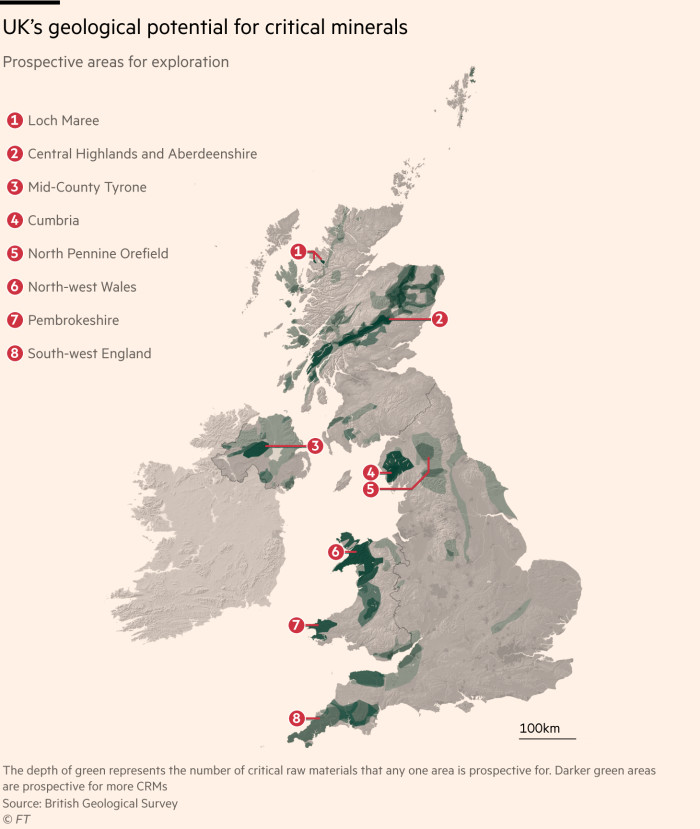UK geologists have identified eight prospective areas to scour for minerals vital for clean energy technologies in one of the first steps towards realising the country’s plan to strengthen raw material supply security.
Regions from Scotland’s Highlands to south-west England have the right geology to potentially yield 18 metals and minerals, including cobalt and lithium, identified by ministers as critical to economic security, according to a report by the British Geological Survey on behalf of the government-funded UK Critical Minerals Intelligence Centre.
The mapping of possible mineral deposits marks the first time that the UK has systematically identified geological potential for the resources needed to produce electric car batteries, semiconductors and wind turbines.
“The UK has geological potential for critical minerals but it has been underexplored,” said Eimear Deady, mineral resource geologist at BGS. “A lot of historic exploration was for major commodities such as copper, lead, zinc and gold, and critical minerals were not considered.”
Deady described the research as “the first comprehensive mapping of its kind”, but cautioned that any discoveries would require subsequent exploration and then take between 10 and 15 years to yield metals on an industrial scale.

The BGS also stressed that its study took account only of geology, meaning that economic, environmental or societal factors could stifle the development of resources, even if further exploration identified sizeable deposits.
The UK relies almost entirely on imports to meet its critical mineral needs. The government deems critical minerals — which include rare earths, silicon and magnesium — to be crucial in spurring clean energy and advanced technologies such as semiconductors, and considers security of supply to be at risk.
Concerns over China’s control of the resources’ supply chains have mounted since Russia last year cut gas supplies to Europe. In July 2022, the UK published its first critical raw materials strategy, which was refreshed last month to take account of fiercer geopolitical competition following Moscow’s invasion of Ukraine.
Five of the eight prospective areas named by the BGS lie outside England; two are in Scotland, offering the country the chance to potentially secure new sources of mineral wealth around Loch Maree and parts of the central Highlands and Aberdeenshire as its hydrocarbon output dwindles.
Parts of Northern Ireland and Wales also show promise for cobalt, nickel and manganese, all key metals for EV batteries.
The three zones within England — Cumbria, the North Pennines and the south west — could contain lithium, graphite and antimony.
All eight areas have been mined historically or are at present under exploration. While almost all extraction of metals ended in the UK in the 1960s, FTSE 100 group Anglo American is developing a multibillion-pound fertiliser mine in North Yorkshire, the largest such project in decades.
Tungsten West, listed on London’s junior Aim market, is also reviving a tungsten and tin mine near Plymouth.
Analysts have warned, however, that without addressing supply chain resilience, any attempt by the UK to capitalise on geological deposits risks failing because of a lack of domestic mineral processing and manufacturing industries.
In particular, the UK has struggled to attract battery plant investments from private companies that would form the basis of a transition by the automotive industry to EVs.
“If there isn’t someone in the UK to buy the minerals, then they will leave the country,” said Deady.









